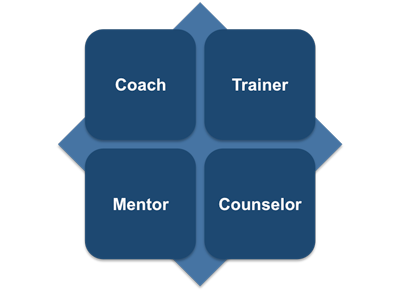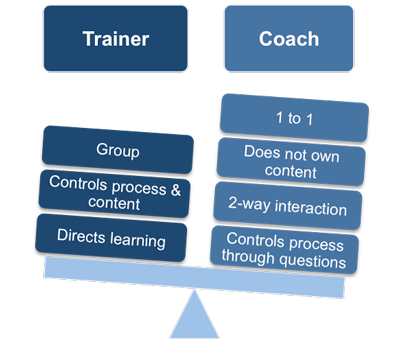One of your prime functions as a manager is to develop those reporting to you so that they attain their maximum potential and productivity for the organization and themselves. There are many different ways individuals learn:
- Skills can be developed through coaching
- Skills can be taught
- Skills can be learned from an expert
- Skills can be reviewed by looking at past behaviors

Organizations may use all four methods to assist the development of their employees. Managers are increasingly expected to be able to competently perform each of the four ‘learning’ roles – trainer, coach, mentor, and counselor – for their team as the need arises.
Expecting every manager to be able to perform each role to the same level of competency is in many ways unreasonable. Organizations often poorly equip managers to perform these roles and offer little guidance as to how best to perform the role. You need to understand how each form of learning operates, and the differences between them, and ensure your behaviors match the role you need to perform in order to meet your objectives.
The role of ‘manager as coach’ is becoming more widespread, especially in organizations that have a culture of empowerment. This creates more and more situations where managers find themselves in a coaching role rather than that of trainer, mentor, or counselor. The rest of this section is dedicated to explaining how the coaching role differs from that used when training, mentoring, or counseling people.
The ways in which the coaching and training roles approach learning are quite different. Training is principally directive: it is driven by the trainer, who will control most of both the process and the content in order to transfer knowledge or develop a new skill as efficiently as possible. The effectiveness of training depends on the competence of the trainer and the aptitude of the trainee for the subject being taught.

Coaching on the other hand is driven by questions addressed to the coachee, who then explores what they already know, but in a way that would probably not occur to them without the guidance of a coach. The coach controls the process, but for it to be really effective, the coachee has to own the content.
Another difference is that people are often trained in groups and this does not reduce the quality of the training received in any appreciable way. However, coaching must always be done on a one-to-one basis.
Although they are distinct activities, training and coaching can work well when used together. One obstacle encountered in business education is the difficulty of transferring skills and enthusiasm from a training course to the workplace. Coaching can be an excellent way of helping people to apply what they learn from a training course and incorporate it into their day-to-day work.

Leave A Comment
You must be logged in to post a comment.